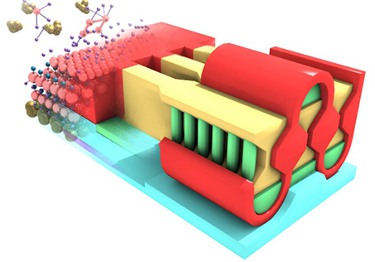 |
| September 19, 2017 | Volume 13 Issue 35 |
Designfax weekly eMagazine
Archives
Partners
Manufacturing Center
Product Spotlight
Modern Applications News
Metalworking Ideas For
Today's Job Shops
Tooling and Production
Strategies for large
metalworking plants
DARPA bushwhacking into unexplored transistor territories
Since the advent of microelectronics in the mid-20th century, humanity has been on a nonstop sprint to eke more speed, power efficiency, and computational power from the sextillions (1021) of ever more miniaturized transistors that have come to underlie so much of the modern technoscape. Even so, the materials scientists, electrical engineers, and other specialists who are leading this decades-long advance know that astounding technological opportunities abound within both existing and yet-to-be-imagined semiconductor structures.

When it comes to transistors that generate and receive radiofrequency (RF) and millimeter-wave signals -- which are central in defense-relevant domains such as communications, signals intelligence, and electronic warfare -- DARPA's new Dynamic Range-enhanced Electronics and Materials (DREaM) program is designed to provide openings to these path-breaking advances.
"The same basic transistor types have been dominant since their invention, and we have been engineering the heck out of them for 50 years," says Dan Green, a program manager in DARPA's Microsystems Technology Office (MTO) and the overseer of the DREaM program. "We've gotten a lot out of that approach, but the focus on so few types of transistor technologies and just a few semiconductor materials also has fundamentally limited us in the RF world. With DREaM, we want to rethink all of that and imagine new possibilities."
The time for such rethinking indeed is now. An already enormous and exponentially growing cacophony of RF and millimeter-wave signals (shorter-wavelength and higher-frequency signals than those in the RF range) from civilian and military gadgetry, including everyday smartphones, long-range radars, and frequency-hopping RF jammers, is threatening to overcrowd the electromagnetic (EM) environment. As the Internet of Things and its billions of wirelessly communicating devices (UAVs, home appliances, and military and household sensors, for example) emerge, the RF and millimeter-wave environment will become even more complex, noisy, and challenging to use. Transistors with unprecedented performance, especially in frequencies important for wireless communication, could become important parts of the solution to these challenges.
Green is drawing strength from DARPA's long history of innovation in semiconductor technology. Over the past quarter century, the agency's programs have laid down foundations for transistor technology based on the semiconductor materials gallium arsenide (GaAs) and gallium nitride (GaN), for example. Compared to silicon-based technology, the backbone substance of the microelectronics revolution, GaAs circuitry operates at the higher frequencies and signal amplification powers that have made practical a world connected by palm-sized cell phones. GaN circuitry can operate at yet higher powers and frequencies and have given the U.S. military an edge in electronic warfare by enabling its radars and jammers to work at greater distances than its adversaries' corresponding technologies can.
The strategic challenge for researchers who become part of the DREaM program, Green says, will be to rail against the seemingly inescapable performance tradeoffs between four key characteristics of RF transistors:
- Signal power, which determines an RF system's range of operation;
- Power efficiency, which determines the size and weight of the power system required to run them;
- The range of frequencies (bandwidth) in which the transistors work; and
- The system's so-called linearity, a measure of the fidelity at which a receiver can amplify signals, including weak ones that otherwise would get lost in the cocktail party of signals that a receiver's amplifier is likely to process in a battlespace.
The DREaM program is all about reducing the traditional limitations of this "trade space," as Green refers to it, so that engineers will be able to design smaller, less power-needy RF systems that nonetheless operate at larger electromagnetic bandwidths with unprecedented linearity. "Our goal is that DREaM transistors will transmit and receive the large and complex RF signals of the future, and they will do so in smaller packages while consuming minimal power," says Green.
To achieve these technical goals with the DREaM program, Green hopes to push transistor technology futureward along two mutually reinforcing directions. One centers on new materials that can accommodate more electrical charge and voltage without degrading than currently known materials can. Advances on this materials front could open the way to the higher-power and more capable transistors the DREaM program seeks to develop. Ultrawide bandgap materials (UWB) such as complex oxides, which include gadolinium titanate and strontium titanate, and even particular crystal variants of GaN, are among the many possible candidates for research in this area.
Researchers engaging in the second technical area, which focuses on the linearity of transistor behavior over wide ranges of signal frequencies, will investigate unconventional transistor structures, among them nonplanar and filamentous ones, such as ones based on carbon nanotubes, as well as still-to-be-imagined geometries and layouts that are not constrained by the row-and-column transistor formats of today's integrated circuits.
Source: DARPA
Published September 2017
Rate this article
View our terms of use and privacy policy
